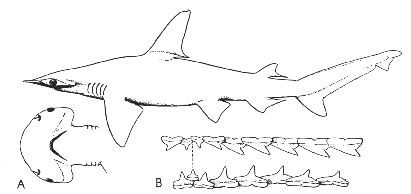Shovelhead Sphyrna tiburo (Linnaeus) 1758
BONNET HEAD SHARK
[Bigelow and Schroeder, 1948, p. 420.]
[Garman, 1913, pl. 1, figs. 4-6 (as Cestracion tiburo).]
Description—
The peculiar shovel-shaped head of this shark is enough to distinguish it readily from any other shark known from the Gulf of Maine, except for the hammerhead, from which it is readily distinguished by the fact that its head is considerably narrower, is more rounded in front, and is not deeply indented opposite each nostril; that the posterior margin of its anal fin is only weakly concave, and that the outermost four or five of its lower teeth next each outer corner of its mouth are low and rounded, not blade-like. The eyes of the shovel-head shark, like those of the hammerhead, stand at either edge of the expanded head; the first dorsal fin originates a little behind the "armpit" of the pectoral, is somewhat higher than the pectorals are long, and is higher than long; the very small second dorsal fin originates a little behind the origin of the anal fin; the upper lobe of the tail is notably long (about one-third as long as the body of the fish) and deeply notched near the tip, the lower lobe is about one-third as long as the upper lobe. The anal fin is larger than the second dorsal fin, its posterior margin is only slightly concave; the pectorals are broadly triangular, their anterior margins about as long as the distance from the level of their own points of origin to the front of the mouth.
Color—
Gray or grayish brown above, and a paler shade of the same below; some are marked with a few small dark, roundish spots along the sides.
Size—
This shark is much smaller than the hammerhead, rarely exceeding 5 feet in length; it is said to reach 6 feet.
General range—
Tropical-warm temperate Atlantic; from southern Brazil to North Carolina, in the west, and as a stray to southern New England and Massachusetts Bay; tropical West Africa in the east; also from southern California [page 45] to Ecuador on the Pacific Coast of America, or represented there by a very close relative.[9]
Occurrence in the Gulf of Maine—
Our only reason for including the shovel-head here is that a stray specimen has been reported from Massachusetts Bay.[10] It has also been taken once at Newport, R. I., and a commercial shark fishery that was carried on in Nantucket Sound in the summer of 1918 is said to have yielded six of them.[11]
[9] On this point, see Bigelow and Schroeder, Fishes of the Western North Atlantic, Pt. 1, 1948, p. 425, footnote 20. A shark has also been reported as tiburo from China and from the Philippines, but without convincing evidence as to its identity.
[10] By Garman, Mem. Mus. Comp. Zool., Vol. 36, 1913, p. 161. Apparently the specimen is no longer in existence.
[11] Personal communication by R. H. Bodman, who operated this fishery.
